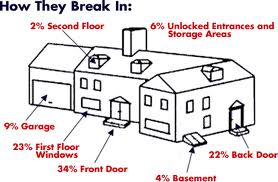Recently by Chris Martenson: Alert: Nuclear (and Economic) Meltdown In Progress
In my first post on crime, I urged you to accept the reality of the criminal threat and to mentally choose not to allow yourself to be easily victimized. Hopefully, you’re reading this second post because you’ve sworn off the denial, distraction and passivity that characterizes most people and decided to do whatever you reasonably can to protect yourself, your family and your home. If this mindset of yours is authentic and deeply felt, you’re more than halfway to your goal.
 Your next step is to form a self-protection plan. Helping you do that is the purpose of this second post. “Self-protection” is too large of a subject so I’ve narrowed it down to something you can reasonably take on in the near future: fortifying your home and yourself against crime. I’m going to focus on three types of crimes because your plans to defend against all three are closely related.
Your next step is to form a self-protection plan. Helping you do that is the purpose of this second post. “Self-protection” is too large of a subject so I’ve narrowed it down to something you can reasonably take on in the near future: fortifying your home and yourself against crime. I’m going to focus on three types of crimes because your plans to defend against all three are closely related.
1. Burglary when your house is unoccupied. 2. Burglary when you are home. 3. Home invasion robbery.
Legal definitions vary from state to state, but in Pennsylvania burglary is defined as unauthorized entry into your home or other building (with or without the use of force) with the intent to commit a theft or a felony. Burglary is considered a property crime because the usual intent is to steal valuables that are not in the physical possession of another person. By contrast, robbery is stealing valuables from a person using or threatening to use force. Robbery is a violent crime against a person for the purpose of theft.
Most burglaries are intentionally committed when the criminal believes the house to be empty. Burglars want to avoid being confronted by a home’s occupants because they’re afraid of getting hurt by the homeowner or captured by the police. Most burglars are unarmed when they break in (except for a tool they might have used to force entry) because they have no intention of having to hurt someone to complete their crime and safely escape. This crime presents the least amount of physical danger to you, but it is by far the most common of the three. Whatever plan you come up with has to address this issue comprehensively. Fortunately, most of your plans to prevent burglary will be useful in your plans to deal with the next two crimes which are far less frequent, but far more dangerous to your physical safety. Check out this typical burglary story caught on video. The teenage burglars crawled in through a “pet door” on an exterior door, ignored the friendly pets (2 dogs, a cat, and a noisy bird), and ransacked the house (“so easy a caveman could do it!”). Atypically, the owner, who had been previously burglarized had set up a security camera in her house which she monitored live via the internet while she was at work. She saw the intruders, called police, and the two boys were arrested. It would have been a good idea to get rid of the pet door. Anyone want to bet these were the same two who burglarized her place the first time?




